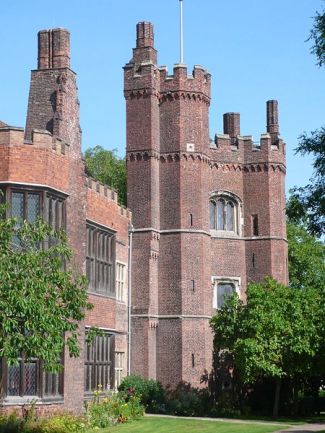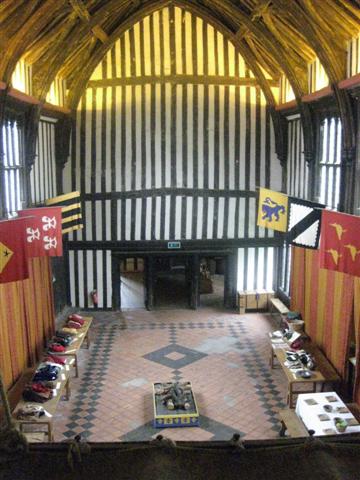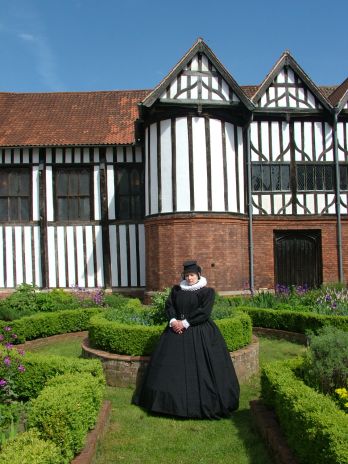Gainsborough Old Hall, Lincolnshire UK
Jump to navigation
Jump to search
| 80px|Tudor rose Gainsborough Old Hall Lincolnshire, England, United Kingdom |
 Gainsborough Old Hall in Lincolnshire is over five hundred years old and one of the best preserved medieval manor houses in England. Gainsborough Old Hall in Lincolnshire is over five hundred years old and one of the best preserved medieval manor houses in England.The Hall was built by Sir Thomas Burgh, 1st Baron Burgh of Gainsborough in 1460. The Burghs were rich, flamboyant and powerful people. Gainsborough Old Hall was not only their home, but also a demonstration of their wealth and importance. Sir Thomas was a great benefactor to Newark Church and also the founder of the Chantry and Alms House at Gainsborough. In 1470, the manor was attacked by Sir Robert Welles over a clash about lands, status, and honour, but it was not severely damaged. It was in 1484, that Sir Thomas entertained King Richard III in his hall.[1] In 1510, Sir Thomas Burgh's son, Edward Burgh, 2nd Baron Burgh, was incarcerated at the Old Hall after being declared a lunatic. Sir Edward died in 1528, leaving his eldest son Sir Thomas as head of the family. In 1529, his son and heir, Sir Edward, married Catherine Parr. The couple would stay at Gainsborough Old Hall until 1530; when they were granted their own manor in Kirton-in-Lindsey.[2] King Henry VIII also visited Gainsborough twice; once in 1509 and again in 1541 with the doomed Queen Katherine Howard. Architecturally it has changed very little over the years. It is principally a timber framed building, giving it its characteristic 'striped' or 'black and white' appearance. On the north east corner is a brick tower. A splendid view of the town awaits those who brave the fifty-nine step climb to the top.  Today, the Hall with its elaborate timber roof survives as well as the kitchen—possibly the most complete medieval kitchen in England. The Hall is over five hundred years old and one of the best preserved medieval manor houses in England.[1] The Hall is a fine example of upper-class buildings in medieval England, and, because of this, students in Gainsborough, Lincolnshire are taken to the hall as part of their Historical studies. There is a story that a daughter, supposedly called Elizabeth, of Thomas Burgh fell in love with a servant or poor soldier. As punishment she was locked in the Tower where she starved to death. Over the years people have reported sightings of her especially in the tower room. Another story is of a ghost described as a 'grey lady' who is often sighted walking the long gallery towards the tower bedroom where Queen Katherine Howard stayed while visiting. Scratched into the plaster walls in another room is a chilling piece of graffiti dating from that visit - the words 'Trust truth Only' and the signature of it's creator - one Philip Tyrwhit. Sir Thomas, son of the 2nd Baron married Agnes Tyrwhit, daughter of Sir William. <a class="external" href="http://en.wikipedia.org/wiki/Wikipedia:Citation_needed" rel="nofollow" target="_blank" title="Wikipedia:Citation needed"> </a> The house is now owned by English Heritage and is open to the public as a museum. Sources:[1] John Julius Norwich. Treasures of Britain; the architectural, cultural, historical and natural heritage of Britain. W. W. Norton & Company, 2002. pg 262.[2] James, Susan E. Kateryn Parr: The Making of a Queen. Aldershot, England: Ashgate Publishing Ltd. 1999. pg. 60-63. |
 If you love Tudor history then a visit to Gainsborough Old Hall is a must! The house was sold to the Hickman family of London in 1596. The Hickman's were favourites at the courts of King Henry VIII, Edward VI and Elizabeth I. If you love Tudor history then a visit to Gainsborough Old Hall is a must! The house was sold to the Hickman family of London in 1596. The Hickman's were favourites at the courts of King Henry VIII, Edward VI and Elizabeth I.There is a scene in The Tudors where a minion delivers a box of quail eggs to satisfy the cravings of Queen Jane Seymour. The "minion" would happen to be Sir William Locke, King Henry's personal and most trusted Royal Mercer - who also acted as a spy overseas. Sir William was Lady Rose Hickman's father. Lady Rose wrote an account of her life at the age of 87 at Gainsborough Hall telling of his exploits. One account recalls her father smuggling English Protestant translations of the Gospels into the then England under Catholicism doctrine. One of his special clients Rose wrote was none other than Anne Boleyn. After the shooting of fellow Protestant, Robert Packington, outside of her childhood home of Cheapside in London, Lady Rose's mother told her to not tell anyone that she had been reading the translated Bible to her children in English. Lady Rose Hickman and her family suffered terrible persecution during the reign of Queen Mary for their religious beliefs. In her old age, Lady Rose sheltered others facing religious persecution while living at Gainsborough Old Hall. Many of the persecuted would become known as the Pilgrim Fathers. The story of Lady Rose - in direct parallel to The Tudors series - is faithfully retold in the novel 'Tudor Rose' by Sue Allan (pictured above outside of Gainsborough Old Hall) using her own account. <a class="external" href="http://www.mayflowermaid.com/ladyrosecharactertous.htm" rel="nofollow" target="_blank"> </a> <a class="external" href="http://www.mayflowermaid.com/ladyrosecharactertous.htm" rel="nofollow" target="_blank">Lady Rose Gilman Tours of Gainsborough Old Hall</a> |